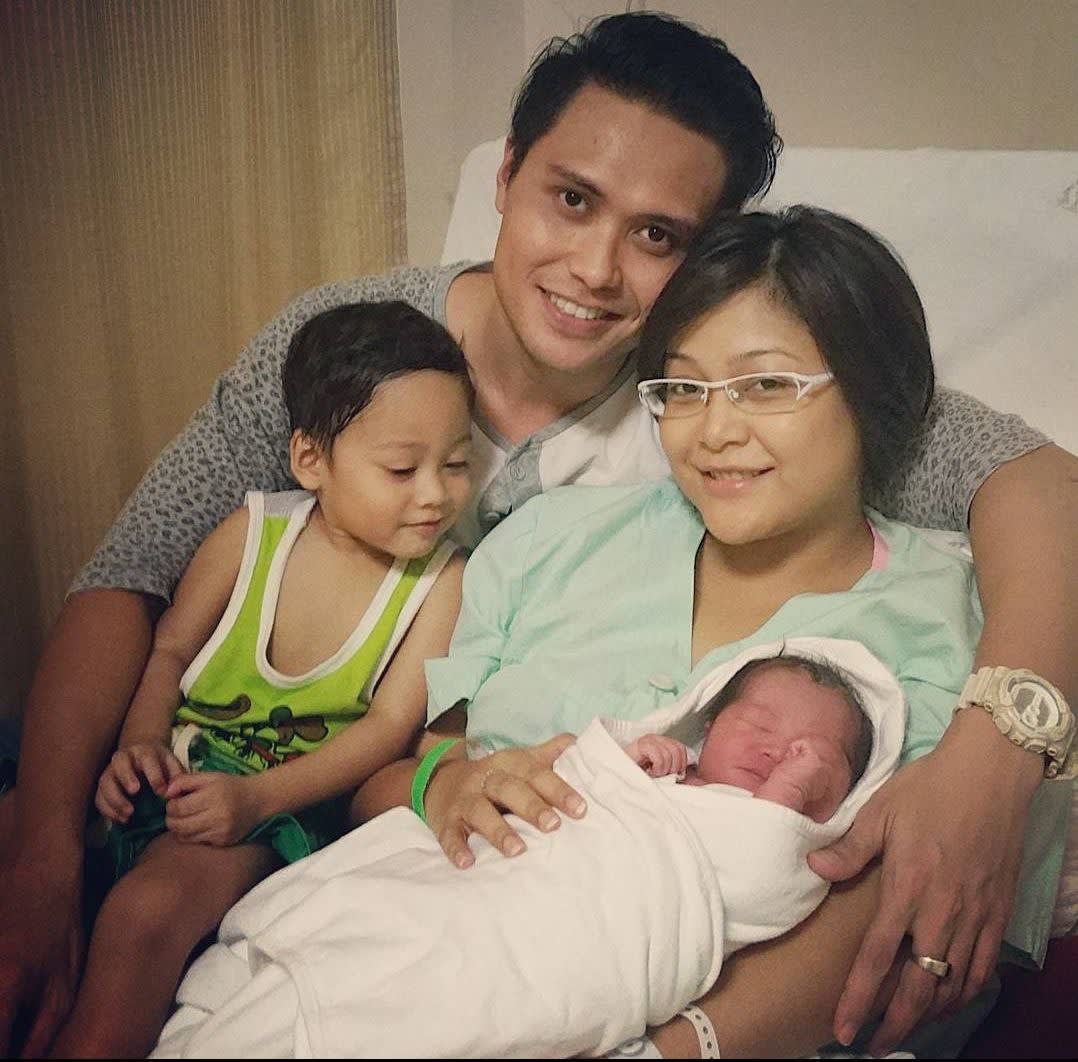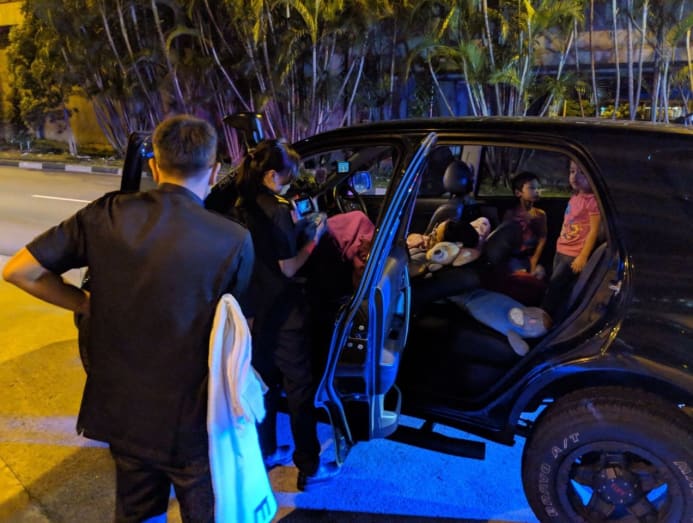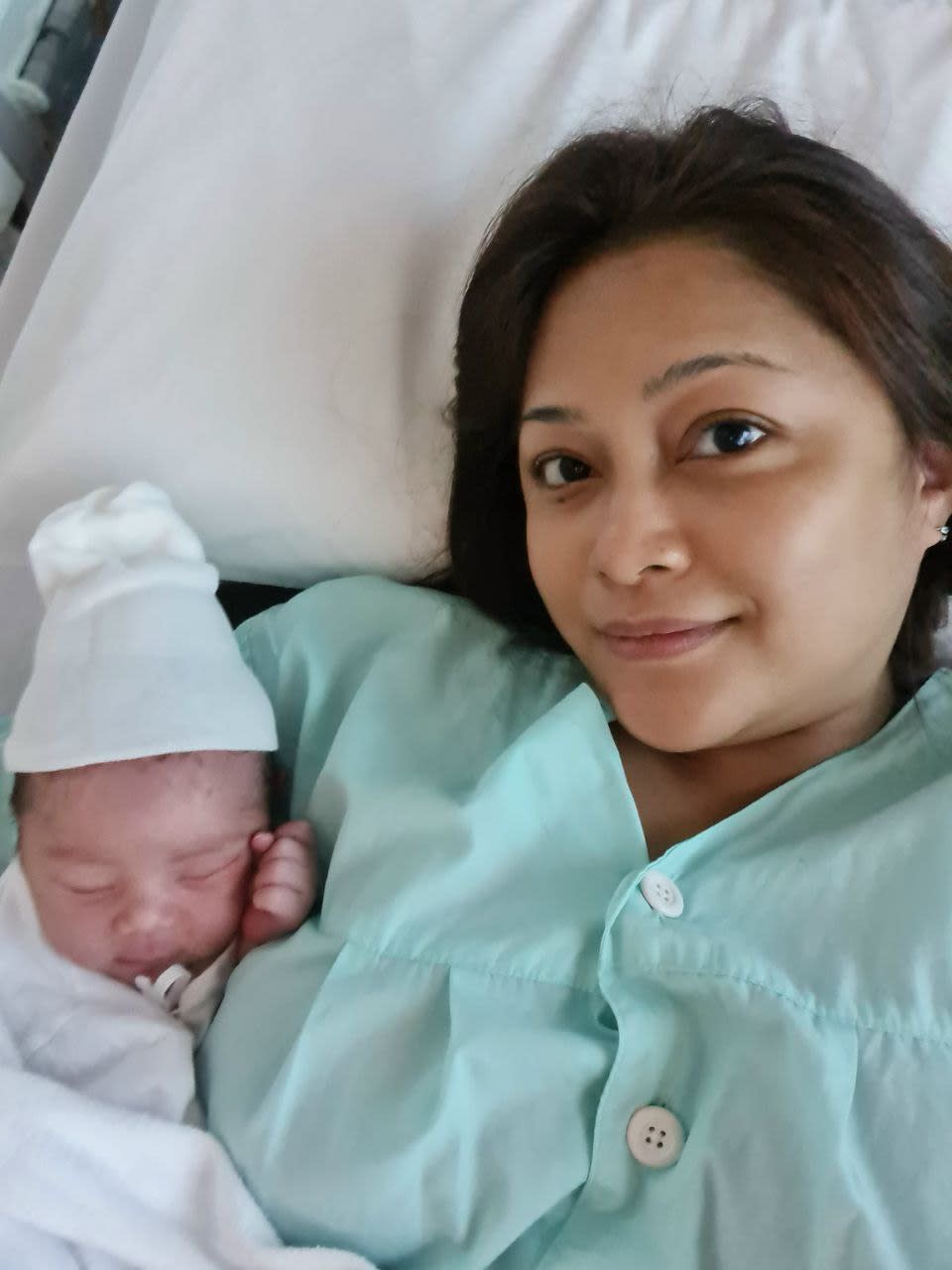‘All my 4 kids were born through rapid labour, including 1 at home and another in the car’
It ironically all started one F1 weekend. Communications consultant Jannah Ismaeil’s first child was born within an hour of contractions – she didn’t even get the chance to leave home. The rest of her four children were similarly born fast-and-furious style. As told to CNA Women's Hidayah Salamat.

(From left) Jannah Ismaeil, her husband Fir Rahman and their four kids. (Photo: Jannah Ismaeil)
The year was 2013. It was a Sunday, the weekend of the Formula One Night Race. I remember my husband (actor Fir Rahman) had been at a shoot earlier in the day. I’d told him I was craving durian snowskin mooncake, so he brought some home for me.
That night, we slept on a mattress in one of the bedrooms at the three-room Toa Payoh flat we shared with my late father-in-law. I got up some time before dawn, needing to urinate.
I didn’t think much of it – I was into my 36th week of pregnancy and it’s a fairly normal occurrence for that stage. I also felt the urge to do a number two but nothing happened. I went back to sleep.
Shortly after, Fir and I both woke up. I think he thought the mattress was wet. I needed to go to the bathroom again. And again, nothing came out.
Groggy, we both went back to sleep. It didn’t last long.
Minutes later, I felt a discomfort like nothing I’d felt before. I got up, went on all fours and started swaying about – a pain-relieving method I’d learned in a prenatal yoga class.
But then the pain escalated, expanding across my entire midsection and back, and I began to scream. I wasn’t savvy enough at the time to use a contraction timer app but I remember the pain came in waves.
Then came the “ring of fire”.
The “ring of fire” is the pain that tells you the birth is already happening. During labour, you first feel the pain in your abdomen, but just as the baby is about to make its exit, it feels like your vagina is ballooning. That’s a different level of pain altogether.
Instinctively, I shouted: “The baby is coming! The baby is coming now!” and told Fir to get a pair of scissors from the kitchen.
As he went off to the kitchen, I could feel that the baby’s head had already begun to emerge. I didn’t push – I just remembered what I’d learned in prenatal class about breathing so I did that.

As Fir cut my underwear away, I kind of knew to breathe the baby out and it whooshed out. Thank God Fir caught him.
The whole thing – from that first time I had to use the toilet up until the baby was born – was less than an hour.
Fir by this time had collected himself so he called an ambulance. I remember paramedics injected me with something to help eject the placenta but I can't recall if that happened at home or in the hospital.
My firstborn, Ilhan, was born at 35 weeks and five days – a tad premature. I’m not sure if it was that, the fact he was born in a non-clinical environment or both, but he was placed in the special care nursery at KK Women’s and Children’s Hospital (KKH) for nearly two weeks.
With our second child, Izza, the birth was what I would describe as the most “normal” of the lot. Hers was a rapid birth as well – labour was three hours long – but she took the longest out of all our kids. And she was born in the delivery suite at the National University Hospital (NUH).
“ON THE WAY”
But Indra, our third, was born in the car.
I remember everyone was sick with stomach flu so I was quite tired. At about 10pm, Fir came home from work with some food. We sat on the sofa together and I ate while he watched some television.
I was already feeling a little uncomfortable, but I was hungry (Fir had brought my favourite: Fried beehoon with mutton) and thought it could be cramps from the stomach flu, so I kept quiet.
But Fir noticed the grimace on my face and suggested it was time to leave for the hospital. As I showered, he got the kids ready. In the shower, I had to pause every few minutes because the pain was getting unbearable. The shower took longer than usual.

Fir went to get the car while I waited at the pick-up point of our HDB estate at McNair Road with Ilhan and Izza.
NUH is really far away from the Whampoa area. To get to the hospital, we meant to go along Serangoon Road before entering the slip road towards the Central Expressway. It was around midnight by that time, so it would’ve taken us less than 10 minutes to get from our home to the expressway. But by the time we got onto the slip road, the intensity of the pain had gotten too great.
“Dear, I cannot. I can feel it already. You have to stop. You have to stop now,” I told Fir.
He parked the car at what appeared to be an emergency stop area along the slip road and ran over to my side. Just as he helped me remove my underwear, the baby came out. I screamed the baby out. I think I forgot to breathe – the pain was more intense this time, more than with Ilhan.
The paramedics came some time later. One of them was new. I think this was his first time witnessing a delivery – he must’ve been traumatised.
The other paramedic was very good to me. She was calm and encouraging. I told her I wanted to wait to cut the umbilical cord. I wanted delayed cord clamping for the benefits that it purports to provide, including better iron concentration and neuro-development in children.
She agreed to wait a few minutes, until I was ready. I felt really lucky to have gotten a paramedic who understood and was supportive of my decision. I only delivered the placenta in the hospital.

According to his birth certificate, Indra (my third child) was born “on the way to hospital”. Actually, I can’t remember if it says “on the way to hospital”, “on the way to NUH” or “on the way to KKH”. We meant to go to NUH but the paramedics rushed us to KKH because it was nearer.
Indra’s birth was magical because who gives birth in a car, on the side of the road? Thinking back on it now, if we had stopped a second later, I would’ve had to give birth on the CTE. Where would we have stopped – the road shoulder? It would’ve been so dangerous for the kids.
Throughout the birth, the kids were standing in the back, terrified. Fir later told me Izza (my second child) kept asking: “Why is Mama screaming so loudly?” The screaming must have been really loud, especially in a confined space.
“WHAT THE HECK DID I JUST DO?”
Finally, last year, we had Izzul. Same thing as the rest – the moment I felt pain, we left home. I had a helper this time so the other kids stayed home in her care.
It was in the middle of the night and we were in the middle of the COVID-19 pandemic. With most of my births, we arrived in hospital in an ambulance so we struggled with parking. Fir dropped me off first at the Accident and Emergency department, and by the time I got there, the pain was already super intense.
I felt like I was waiting there in a wheelchair forever. I heard the delivery suite was full so they eventually led me to a bed within A&E. Knowing my history of rapid births, I was getting very anxious. On top of that, Fir was still looking for parking so he wasn’t with me – I really felt that void.

For some reason – maybe because everything happened so fast – I ended up having to manoeuvre my position on the bed myself, without help. At some point, I’m sure someone came forward – there were several people around me, like it was a party – because I screamed, “You need to help me, I’m giving birth already!”. I didn’t have the energy to get on my fours so I ended up lying on my side.
I spread my legs and breathed the baby out. Everyone around me was obviously shocked.
I only saw Fir when I was wheeled out to the delivery suite. I was so sad he missed all of that. While recuperating in the hours after my birth, for the first time, I felt severe chills. I was shaking. I read later that it’s a common condition for mums postpartum. But as it was the first time it was happening to me, I was scared. The hospital staff piled blankets on me and I felt better.
The rapid labour experience is a unique one. The pain goes from nothing to intense really quickly, and that can be traumatic. Usually, labour takes hours, so you have time to mentally prepare as the pain progresses in intensity. With rapid births, your mind can’t catch up with your body.
Especially with Ilhan, my firstborn, right after giving birth, I felt fatigue but also a kind of nothingness. Like, that’s it. It’s done. Shortly after, I was like, “What the heck did I just do?”. Then the feeling of happiness washed over me. I thought, “Wow, Ilhan is here. I survived”.
I also couldn’t believe that Fir did it together with me, that we were a tag team. How many couples can say that? I think it’s super beautiful.
Through stories like this, I hope to always remember what happened and not forget even the smallest details. I also want women in Singapore to have something to refer to, in case any of them go through the same experience.
Until today, I haven’t heard of anyone who shared my experience, except in the United States. Many women in the US have blogs or Instagram accounts on which they share their rapid labour experience. It helped me a lot to know I was not alone. Their stories also helped me find the words to describe what I had gone through.
I’ve found the following values useful in dealing with a rapid birth: Confidence and clarity of mind. Yes, prepare as much as you can. But when it comes down to it, you have to have faith and trust that you’re ready.
All that’s left then is to be determined to get through the pain.
CNA Women is a section on CNA Lifestyle that seeks to inform, empower and inspire the modern woman. If you have women-related news, issues and ideas to share with us, email CNAWomen [at] mediacorp.com.sg (CNAWomen[at]mediacorp[dot]com[dot]sg).









